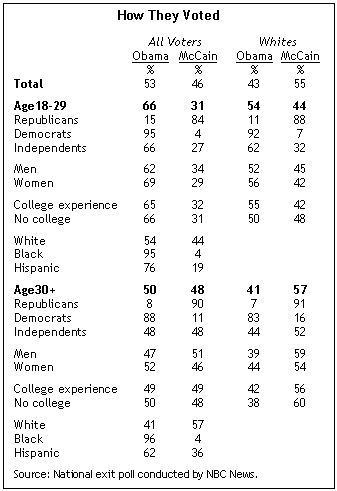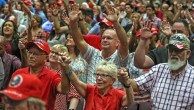by Scott Keeter, Director Survey Research, Juliana Horowitz, Research Associate and Alec Tyson, Research Analyst, Pew Research Center for the People & the Press1
In the last three general elections – 2004, 2006, and 2008 — young voters have given the Democratic Party a majority of their votes, and for all three cycles they have been the party’s most supportive age group. This year, 66% of those under age 30 voted for Barack Obama making the disparity between young voters and other age groups larger than in any presidential election since exit polling began in 1972.

This pattern of votes, along with other evidence about the political leanings of young voters, suggests that a significant generational shift in political allegiance is occurring. This pattern has been building for several years, and is underscored among voters this year. Among voters ages 18-29, a 19-point gap now separates Democratic party affiliation (45%) and Republican affiliation (26%). In 2000, party affiliation was split nearly evenly among the young.
Young voters are more diverse racially and ethnically than older voters and more secular in their religious orientation. These characteristics, as well as the climate in which they have come of age politically, incline them not only toward Democratic Party affiliation but also toward greater support of activist government, greater opposition to the war in Iraq, less social conservatism, and a greater willingness to describe themselves as liberal politically.

Young people were not, however, crucial to Barack Obama’s victory, according to the exit polls. Obama would have lost Indiana and North Carolina, but carried other key states such as Ohio and Florida, as well as the national vote. But young people provided not only their votes but also many enthusiastic campaign volunteers. Some may have helped persuade parents and older relatives to consider Obama’s candidacy. And far more young people than older voters reported attending a campaign event while nearly one-in-ten donated money to a presidential candidate.
While Obama captured 66% of the youth vote, compared with McCain’s 31%, voters age 30 and older divided roughly evenly between the two candidates. Among those ages 18-29, Obama took a majority among whites (54%-44%), and captured more than three-fourths of young Hispanic voters (76%-19%). However, among both younger and older voters, there was no difference in the vote of those with college experience and those without.
As with older voters, a gender gap appears in young voters’ support for the Democratic ticket: 69% of younger women voted Democratic, compared with 62% of comparably aged men.

Describing the Young Voter
One of the most striking features of young voters is their racial and ethnic diversity. Just 62% of voters age 18-29 identify as white, while 18% are black and 14% Hispanic. Four years ago, this age group was 68% white. In 2000, nearly three-quarters (74%) of young voters were white.
Women significantly outnumber men among younger voters, constituting 55% of those 18-29 and 30-44. Among voters ages 45-64, 52% are female, while 51% of voters age 65 and older are women.
Compared with those age 30 and older, fewer young voters say they are affiliated with a religious tradition (16% vs. 12% overall), and fewer report regular attendance at worship services. Among all voters, 40% attend religious services weekly or more often; among those 18-29, just 33% do so.
Party Identification and Issues

The Democrats’ overall advantage in party identification in the 2008 election was driven in large part by the strong Democratic leaning of young voters. Voters ages 18-29 were by far the most Democratic age cohort in the election; 45% identified as Democrats, compared with smaller percentages who identified as Republican (26%) or independent (29%). Older voters also tilted Democratic this year, though by nowhere near the margin found among those under age 30.
The party gap among young voters has expanded over the last four years. Since 2004, Democratic identification among voters under age 30 has increased 8 points, while Republican identification has fallen by 9 points. The percentage of young voters declining to identify with either of the two major parties remained stable at 29%.
In 2000, young voters were about evenly split between the two parties: 36% Democratic, 35% Republican. Notably, young voters were actually somewhat less Democratic than older voters in 2000. For example, those age 65 and older were 4 points more likely than the youngest slice of the electorate to be Democrats.
Consistent with their strong Obama vote and their Democratic Party affiliation, young voters were distinctively liberal in their views on several policy questions. Yet they were similar to older voters in the relative importance of different issues to their vote.

Young voters differ most from older voters in their liberal views on the proper scope of government. Nearly seven-in-ten (69%) of voters ages 18-29 favor an expanded role for government, agreeing that it should do more to solve problems; fewer (27%) say the government is doing too many things better left to businesses and individuals. Opinion on this question is more closely divided among older age cohorts and a narrow plurality of those age 45 and older says government is doing too much.
Young voters also stand out for their opinions on the Iraq war and offshore drilling. A wide 77%- majority of voters under age 30 disapprove of the U.S. war in Iraq, making them at least 15 points more negative on the war than older age groups. While the public as a whole disapproves of the war, opinion is less lopsided with 36% approving of the war. Young voters have soured considerably on the war over the past four years; in 2004, 52% approved of the original decision to use military force against Iraq, and at that time, young voters’ opinions mirrored those of the larger voting public.

While voters overall favor offshore drilling by a margin of more than two-to-one (68% to 28%), those under age 30 express somewhat less support for offshore drilling than do older voters. Yet even so, a 57%-majority of young voters favors drilling for oil in U.S. waters where it is currently not allowed. Fully 72% of those ages 45-64, and 74% of those age 65 and older support increased oil production in U.S. waters.
Nearly a third of young voters (32%) describe themselves as liberal, compared with 22% of all voters. Those under 30 are about as likely as all voters to call themselves moderate, but are significantly less likely to identify as conservative: just over a quarter (26%) of young voters do so. By contrast, voters in older age cohorts are much more likely to call themselves conservative as opposed to liberal.
Despite holding more liberal views on many issues, young voters share the same issue priorities as the electorate at large. More than six-in-ten (61%) young voters see the economy as the nation’s most important problem, about the same share as among the general voting public; the war in Iraq is a distant second on the minds of young voters — as it is among all voters — with 12% naming it the country’s top problem. Voters under age 30 differ somewhat from all voters in viewing energy policy (10% top problem) as a more pressing issue than terrorism (5% top problem); other age cohorts generally consider the issues to be of similar importance or give a slight priority to terrorism.
Mobilization and Turnout
In addition to providing Barack Obama and other Democrats with strong support this year, young voters were unusually active in the campaign. According to Pew’s post-election survey of voters, fully 28% of young voters in battleground states said they had attended a campaign event, far more than among other age groups. They were less likely than older voters to contribute money to the campaign, but according to the survey nearly one-in-ten (9%) did so, compared with the overall average of 17%.
But the electoral influence of young voters also depends on efforts made to mobilize them. According to the exit polls, young voters in key battleground states this year were far more likely to have been contacted by the Obama campaign than by the McCain campaign – and in some states they were more likely than older voters to have been contacted, a significant reversal from past patterns.
Nationally, a quarter of voters (25%) 18-29 say someone contacted them in person or by phone on behalf of the Obama campaign about coming out to vote. By contrast, just 13% were contacted by the McCain campaign. In 2004, nearly the same share of young voters was reached by the Kerry campaign (22%) as was reached by the Bush campaign (19%).
But the disparity was much larger in some of the key battleground states. In Pennsylvania and Nevada, which Obama carried by double-digit margins, more than half of voters under age 30 said they were contacted by the Obama campaign (54% in Pennsylvania and 61% in Nevada). The McCain campaign reached considerably fewer young voters in those states — 30% in Pennsylvania and 26% in Nevada. Obama’s get-out-the-vote operation also reached three times as many young voters as McCain’s operation in Indiana (45% vs. 15%) and twice as many in Florida (32% vs. 16%).

The Obama campaign also reached more voters than the McCain campaign across some older age groups, though the advantage was generally more modest than that among 18-29 year-olds. In North Carolina, for example, 46% of voters under age 30 reported being contacted by someone in the Obama campaign about coming out to vote, compared with 29% who reported being contacted by the McCain campaign. However, Obama’s get-out-the-vote advantage narrows somewhat among those ages 30-44 (11 points) and ages 45-64 (6 points) and completely disappears among those age 65 and older (29% each).
With the exception of Virginia, Nevada, and Wisconsin, the two campaigns were about even in their efforts to turn out voters age 65 and older in the swing states. Obama reached far more older voters than McCain in Virginia (55% vs. 45%) and Nevada (47% vs. 38%), while McCain reached more voters age 65 and older in Wisconsin (58% vs. 46%).
Official estimates of voter turnout among age groups won’t be available for several months, but the exit polls indicate that mobilization efforts aimed at young people may have paid off. Voters ages 18-29 turned out at a higher rate in 2008 than in 2004 in several battleground states. Young voters increased their share of the total electorate by five points in Indiana, four points in North Carolina and Virginia — all of which experienced sizeable increases in overall voter turnout — and by lesser amounts in six other key states. By contrast, the young declined as a share of the total in Florida, Pennsylvania, and Ohio. Nationally, young voters were estimated to be 18% of the total, up slightly from 17% four years ago.
Notes
1 Scott Keeter is also an exit poll analyst for NBC News.
